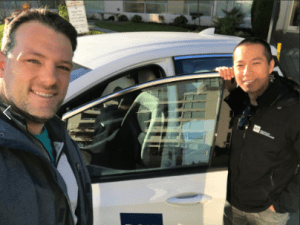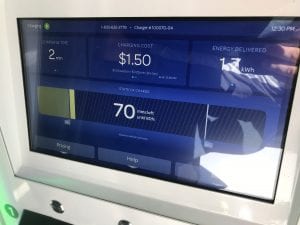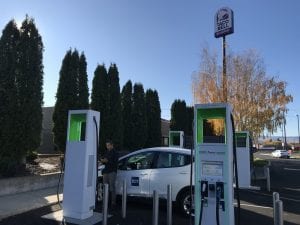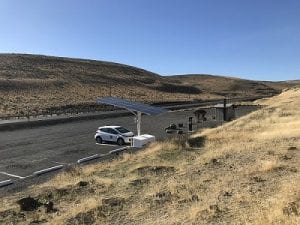This story is written by Colin Chan, Manager of Energy, Facilities and Campus Development at BCIT.

At the end of October, BCIT Sustainability Manager David Pereira and I got to travel down to the Association for Advancement of Sustainability in Higher Education (ASHE) Conference in Spokane, Washington. It was a great conference to connect with fellow post-secondary institutes across the US and Canada and to learn from their sustainability initiatives.
This year, the BCIT North Campus Infrastructure Project was shortlisted as a runner up for a Campus Sustainability Achievement Award out of over 350 applicants.
Compared to flying, driving an electric vehicle (EV) has 80% lower greenhouse gas emissions. So to reduce our travel carbon emissions, we opted to take a Chevy Bolt (Bolt), one of our new electric fleet vehicles from BCIT Facilities and Campus Development. As this was the first long-trip voyage for the Bolt, we were keen to share our EV learning from the journey.
A recap of our long road trip with an EV
The first thing we considered when planning out our trip was charging the vehicle. In a gasoline car, you assume there will be gas stations all over the place, and hence don’t need to do much pre-planning. However with electric vehicles, there are (at least currently) a limited number of charging stations, so you’ll need to plan that out for your route. Plugshare is a great website that layers user-submitted charging stations over Google Maps. It has a trip-planning feature that allows you to enter in your vehicle, your start point and destination, and will map out all the chargers along your route with the range of your vehicle’s battery.

The listed max range of the Bolt is 380 km, which theoretically could get us to Spokane (659 km total distance) with one charging stop. However, from previous experience driving other electric vehicles, I knew that highway driving speeds reduce range (air/wind resistance), and we were going to cross over a mountain (Snoqualmie Pass), which would also eat into the range. We decided to play it safe and plan out two charging stops.
One thing that surprised me was the sheer number of chargers in Washington State compared to British Columbia. As you can see on the map, there were plenty. Orange is DC fast-charging (level 3), which for our car meant approximately 250 km of range gained per hour of charging. At the BCIT Burnaby Campus, we have two DC fast-chargers as part of the OASIS project. Green is level 2 charging, which would provide about 20-30 km per hour of charging. Level 2 is the most common charger that you see at shopping malls, community centres (and at BCIT campuses!).
The driving experience with the car on the freeway was largely the same as a gasoline car. It’s quieter, smoother, but generally, it just drives like a typical car. It’s interesting to see the estimated range left on the battery, and in city driving, you can turn on “one-pedal driving” which brakes automatically whenever you take your foot off the throttle and recharges the battery. It was neat to see that this added a few kilometers of range after picking David up on Burnaby Mountain and driving back down the slope.

Our first stop was an outlet mall just after the pass. It was approximately 280 km from the beginning of our trip, and we reached it with 63 kms of estimated range left in the battery. That’s about 10% less than the maximum range for the car (380km), but as mentioned before, we were doing all highway driving, we crossed a mountain, and we had snow tires on the vehicle. The latter two factors also reduced fuel economy on a gasoline vehicle, but we don’t typically have our car calculating that for us.
When we were done lunch, we came back to the car at 88% charge (300 km range) after 80 minutes and we were on our way. Total cost for the charge was $21.25 USD.

Our next stop was literally at a Taco Bell on the side of the freeway. It had a whole bunch of charging stations for us to use. We went for a walk (no, we didn’t eat at Taco Bell) and came back to the charger after an hour. One mistake I made was not keeping the 10% range reduction estimate in mind, which I soon realized would get us to Spokane with basically an empty battery. We did a quick bathroom pit stop one more time to give us some extra range at a market café in a small town.
I ended up chatting with the store owner and she mentioned that she leases the parking stalls to the charging company (in this case Electrify America). Electrify America installed the chargers, pay for the electricity, and get charging revenues from drivers like us. The store owner gets consistent lease revenue and she appreciates that electric vehicle drivers stop by her store and spend anywhere from a few minutes to an hour hanging out. Sounds like a win-win business model!
When we got to our hotel, the valet found us an outlet in the parkade and we left the car plugged into a standard wall outlet for the duration of our stay. The car estimated it would need about 24 hours to charge to full, which worked for us as we had a two-night stay for the conference.

When we left for our return trip, the car battery was full and we planned to stop at the same locations on the way home. Two factors impacted that plan: cold weather and traffic. It was well below zero and snowing when we left and it seemed to have a negative impact on the range (we were also driving into a headwind). We thought we’d have plenty of range to get back to the Taco Bell, but as we approached, it was clear we weren’t going to make it. Luckily, through the Plugshare app, we found a fun little stopover at a petrified forest, complete with a solar-powered charging station!
The other stop we planned to visit again in the outlet mall was not recommended by Google Maps traffic (Newsflash: Seattle traffic is horrible), so we bypassed Seattle, used the Plugshare app again, found a different charging station, and arrived home with plenty of range left on the battery.
All in all, it was a great learning and exploration experience. As well, a fun low-carbon way to travel over long distance.
Tips for traveling a long road trip with an EV

These are five lessons that we learned from traveling from British Columbia to Washington.
- Don’t fully rely on your car’s range estimator – it calculates range based on past driving, so if your roadtrip will be much different (cold, mountainous, highway driving, snow tires) than the driving the car usually experiences, you should build in some buffer to your own charging range planning.
- The cost of high-speed (Level 3) EV charging in Washington is comparable to gas prices. For 1300 km of driving, we paid just over $100 in charging fees.
- High-speed charging won’t get you to 100% battery level at high speed. The charging slows down after about 85% to ensure battery health, so those last few percentage points of battery take quite a bit longer. Best to plan based on 80% of your car battery range.
- Be sure to factor in charging time to your trip. Each high-speed charging stop for us was about an hour.
- The faster you drive, the shorter the range. Don’t be afraid to take the scenic route and take your time!
Have you subscribed? Sign-up to receive the latest news on BCIT.
Note to media: If you are interested in interviewing Colin Chan, Manager of Energy, Facilities and Campus Development, please contact Amy Chen, 778-984-7245. Colin is able to speak about his trip or tips for traveling long distance on an electric vehicle.
